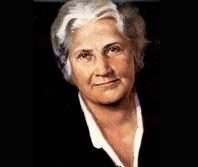
“The environment must be rich in motives which lend interest to activity and invite the child to conduct his own experiences.”
–Maria Montessori
All About Montessori
The Montessori method of education, developed by Dr. Maria Montessori is a child centered educational approach with over 100 years of success in diverse cultures all over the world. It is a view of the child as one who is naturally eager for knowledge and capable of initiating learning in a supportive, thoughtfully prepared learning environment. This approach values each individual child physically, socially, emotionally and cognitively. The Montessori environment contains specially designed, manipulative materials that invite children to engage in learning activities of their own individual choice. Under the guidance of a trained teacher, children in a Montessori classroom learn by making discoveries with the materials, cultivating concentration, motivation, self-discipline, and a love of learning.
Today, Montessori schools are found worldwide, serving children from birth through adolescence. In the United States, there are more than 4,000 private Montessori schools and close to 200 public schools with Montessori programs.
Our Goals
Our Work Is Heavily Shaped by Our Core Values
Goals of Montessori Education
- To foster competent, responsible, adaptive citizens who are lifelong learners and problem solvers.
- To promote learning in an inquiring, cooperative, nurturing atmosphere through self- and teacher-initiated experiences.
- To support learning through the senses, by manipulating materials and interacting with others, leading to the abstract understanding of ideas
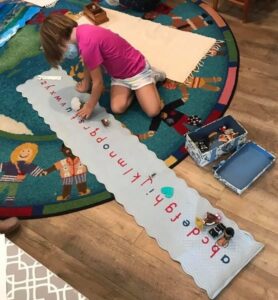
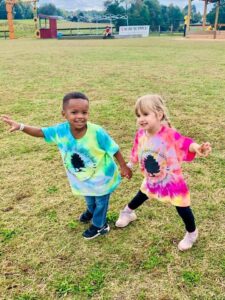
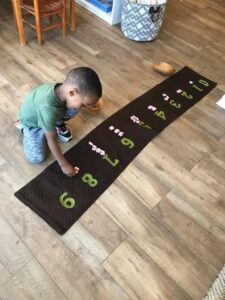
Freedom of Choice
Maria Montessori recognized that when allowed freedom of choice within clear, firm and reasonable boundaries, children act in positive ways that further their development.
Freedom is frequently misunderstood, and many people take it to mean that children can do whatever they want. Montessori believed that freedom without boundaries was abandonment. In Montessori classrooms, expectations are clear, and children experience the natural and logical consequences of their choices.
This freedom within limits allows for the natural development of self-regulation within the society of the classroom, as well as mirroring behaviors expected by society in general.
The Montessori Classroom
There are spaces suited to group activity, and areas where a student can settle in alone. Parts of the room are open and spacious, allowing a preschooler to lay out strands of beads for counting, or an elementary student to ponder a 10-foot-long Timeline of Life. You won’t find the customary rows of school desks; children work at tables or on the floor, rolling out mats on which to work and define their work space. Nor are you likely to find walls papered with brightly colored images of cartoons and syndicated characters. Rather, you might see posters from a local museum, or framed photographs or paintings created by the students themselves. There are well-defined spaces for each part of the curriculum, such as Language Arts, Math, and Culture.
Each of these areas features shelves or display tables with a variety of inviting materials from which students can choose. Many classrooms have an area devoted to peace and reflection: a quiet corner or table with well-chosen items—a vase of daisies; a goldfish bowl—to lead a child to meditative thought. And always there are places to curl up with books, where a student can read or be read to.
Each classroom is uniquely suited to the needs of its students. Preschool rooms feature low sinks, chairs, and tables; a reading corner with a small couch (or comfy floor cushions); reachable shelves; and child-sized kitchen tools—elements that allow independence and help develop small motor skills. In upper-level classrooms you’re likely to see large tables for group work, computers, interactive whiteboards, and areas for science labs. Above all, each classroom is warm, well-organized, and inviting, with couches, rugs, and flowers to help children and youth feel calm and at home.
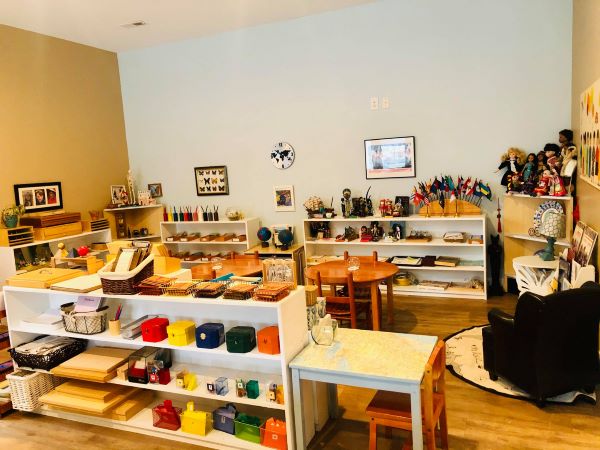
Montessori Education Vs. Traditional Education
Traditional classroom
- Teacher has dominate rule: child is a passive participant in learning.
- One year age cycle in classroom limits collaboration between parents, teachers, and students. Teamwork is limited.
- Values completions of assignments :time is tightly scheduled.
- Standardized work plan for all students.
- Instruction pace is set by a group norm. work is corrected by the teacher. errors are viewed as a mistakes.
- Rote memorization, rewards and punishment reinforce learning externally.
- Conflict resolution is taught separately from classroom dynamics
- Disciplines generally are taught separately. The goal is to master core curriculum objectives
- Measures success against uniform standard. progress reported through report cards and grades
Montessori Environment
- Teacher has guiding role: child is an active participants in learning.
- Three to six years age cycles in classrooms encourages mentoring. Collaboration reinforces learned skills.
- Values concentration and uninterrupted time for focused work cycle to develop.
- Individualized work plans.
- Instruction pace encourages internalizations of information. Child identifies their own errors through self-correcting tools.
- Comprehension and feelings of success reinforce learning.
- Courtesy and conflict resolution are Integral parts of curriculum.
- Multi-disciplinary . interwoven curriculum. Goals is to foster an individual love of learning.
- Measures success through a portfolio of students work progress reports, teacher journals for each student and collaborative conferences.
